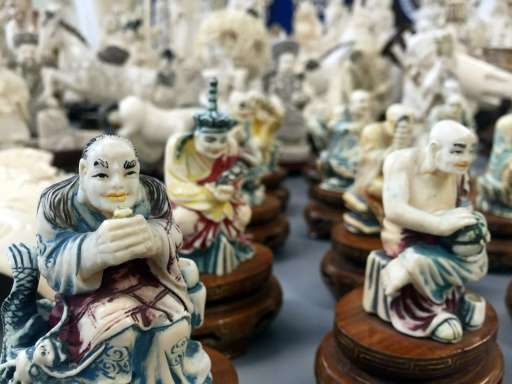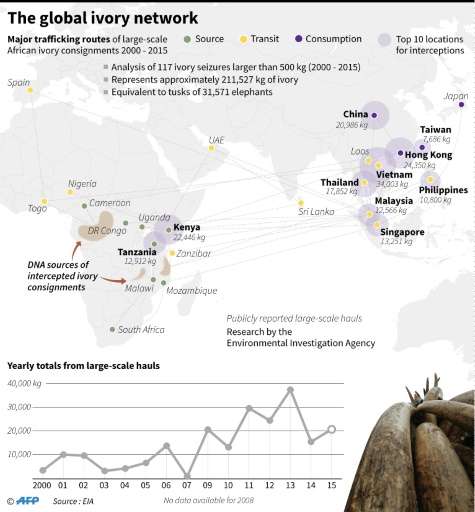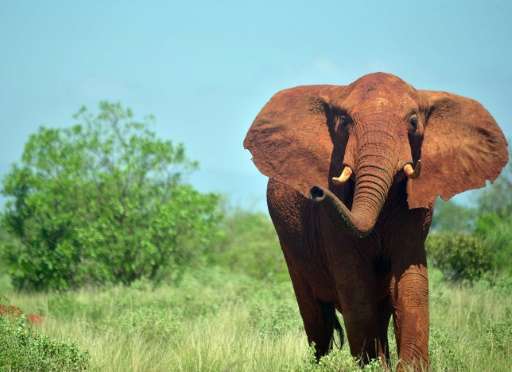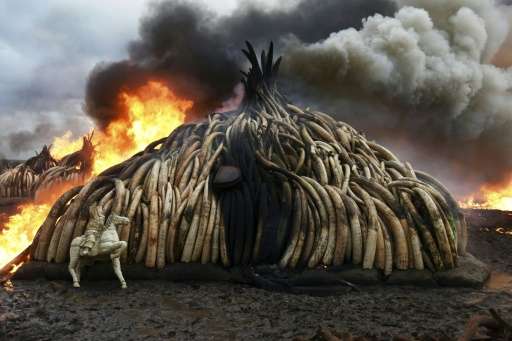France's last ivory carvers faced with extinction

Annick Colette-Fremond is the fifth generation of her family to practise the art of ivory carving—and she may be the last of her line, due to new rules in France.
She is one of just a handful of French ivory carvers left, plying a trade that conservationists say spurs the slaughter of elephants and rhinos.
Colette-Fremond and her fellow craftspeople work with ivory imported before a ban over four decades ago, but say their future will be doomed when a new decree takes effect—and will not stop the killing.
"Sadly, this isn't going to save the elephants," said Colette-Fremond, 64, who operates a workshop in the Normandy port town of Dieppe, once a hub of the ivory trade.
"There's just a handful of us left," said the artist, who showcases sculptures of a crying child, a mother with a baby and a sheaf of wheat. "We are not dangerous."
Elephant slaughter
Defenders of elephants and rhinoceroses, though, say that behind a piece of artwork lies a darker truth.
Poaching over the past decade has sent the African elephant population on its worst plunge in 25 years, according to a report released Sunday at the Convention on International Trade in Endangered Species (CITES) conference in Johannesburg.
Elephant numbers have dropped by around 111,000 in the past decade, putting the continent's total population at around 415,000.

In France, the ivory business has been tightly controlled since it joined CITES, which now includes over 180 countries and bans import of the tusk.
In August, the French government tightened the screw, approving a decree that will ban "the making of objects using ivory... regardless of the age of the ivory used."
The French craftspeople say they are not at fault for the elephant slaughter, and complain their centuries-old art will be destroyed.
At present, they use ivory acquired before the treaty took effect in 1975.
"We work mainly with stock inherited from our forebears," said carver Benoit Migeon.
"We are audited by the authorities. We have a stock book, everything is marked," he said referring to his 250-kilo (550-pound) supply.
'Deadly decree'
The carvers have support from Dieppe town hall, which says ivory carving is an important part of its history.
"The decree from (Environment Minister Segolene) Royal is ineffective in protecting elephants, and quite deadly to the beautiful craft of ivory carving," said Mayor Sebastien Jumel.

Conservationists disagree, saying the carvers—whatever the age of their ivory—indirectly feed demand, and poachers and traffickers benefit.
"This is what drives illegal ivory trade, so the only way to reduce demand is to close domestic markets," said Celine Sissler-Bienvenu, France and francophone Africa director of the International Fund for Animal Welfare (IFAW).
"Given the major crisis elephants are going through, there is no way we can continue to trade ivory," she told AFP at the CITES conference.
Internationally, there is a fierce debate over what to do with ivory stockpiles.
A coalition of 29 African countries is pressing for a total halt to the ivory trade to curb poaching of elephants, but others believe it would only fuel illegal trading.
Namibia and Zimbabwe have made a proposal seeking permission to sell off stockpiles of tusks to raise funds for local communities that co-exist with the animals.
France's new rules are the most stringent in Europe, although even activist groups doubt whether they will have much effect.
"France is not considered to be a major destination for newly poached ivory so it's rather difficult to understand how such a ban will help to save elephants," Richard Thomas, global spokesman for wildlife monitor TRAFFIC told AFP.
"Ivory carvers are currently a dying breed worldwide and that trend looks likely to continue," he added.

In the 16th century, Dieppe—a port whose connections stretched from Scandinavia to Madagascar—was along with Paris the major pole for ivory-carving in France.
The industry was extensive: in just one of the many workshops in Dieppe, 40 people were employed in the 19th century.
They had specific skills for carving, drilling or polishing the ivory, catering to demand from the aristocracy or the rising middle classes at a time when few, if any, thought of conservation.
Carvers worked in poor light—blindness was a risk of the trade—and often fell ill from breathing in ivory dust.
Today, fewer than half a dozen people in France make their living from carving tusk.
Colette-Fremond had hoped her daughter Julia would be able to continue the tradition into the sixth generation.
"Her plans are now in jeopardy," she said.
© 2016 AFP





















